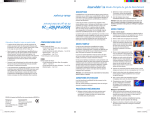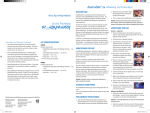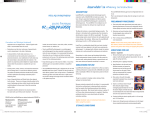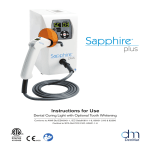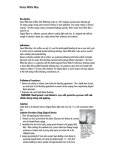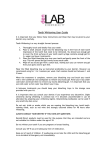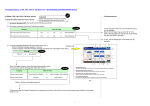Download LaserWhite20 Instructions
Transcript
Whitening Gel Instructions REFRIGERATE IMMEDIATELY! This kit contains: 1 Syringe of whitening base gel 1 Syringe of activator gel 1 Syringe of liquid dam 1 Syringe of desensitizer 2 Applicator tips 5 Brushed applicator tips 2 Syringe caps 1 Disposable clear cap for handpiece CAUTION! • Read Instructions before Treating Patients! • Syringe May be Under Pressure. Handle Carefully. • For Professional Use Only. • Avoid Any Eye and Skin Contact. Rinse Thoroughly with Water if Exposed. • Keep Out of Reach of Children • Not for Injection • Destroy After Use • Strong Oxidizing Agent Whitening Gel Kit Instructions for Use A. Description Contraindictations, Precautions & Warnings [cont.] • • • • • • • • the LaserWhite20™ whitening gel for two (2) applications (sessions) per patient visit, the desired results may be achieved in one application. Do not use Liquid Dam on patients with known sensitivity to resin. It is advisable to test Liquid Dam on a small section of the patient's gum, before attempting this procedure. When curing the Liquid Dam, hold the curing light at least 2 cm away from the resin to reduce any heat-induced sensitivity during curing. Application on the teeth must be uniform and free from gaps to ensure uniform whitening of teeth surfaces. Monitor patient’s progress during treatment, and discontinue use if patient reports sensitivity or discomfort, or if clinical results exceed desired effects for patient and operator. DO NOT anesthetize the teeth for this procedure. If any sensitivity occurs, discontinue the process as stated above. Caution must be exercised regarding the inadvertent transferal of whitening gel from gloved hands or dental equipment onto non-target tissues. Copious irrigation with water is recommended when this occurs. Restorations must be intact, and areas of exposed dentin must be treated prior to the start of whitening. A rebound effect of tooth shade could occur. It is recommended to wait two weeks prior to placement of proximal restorations, since stabilization of tooth shade may take several days to two weeks after the treatment. The patient may experience positive (lighter) or negative (darker) rebound after this procedure is completed for up to two weeks. Existing crowns, onlays, veneers, and composite restorations will not change color due to this whitening process. The • • • • • • patient and dental professional should discuss possible cosmetic implications that existing restorations pose in whitening cases. Areas of hypocalcification will bleach faster than adjacent tooth structure. These are not always clinically evident at the onset of whitening, and when visible, the gel should be placed carefully adjacent to these areas to blend the remaining surface shade. The patient should be advised not to consume products that stain teeth up to 48 hours after treatment. This would include, but not be limited to, some fruits, coffee, red wine, tomato sauces, tea, tobacco, etc. It is NOT recommended to use LaserWhite20™ on those who are pregnant or nursing. Since LaserWhite20™ whitening gel is an oxidizing agent, and oxidizing agents have been reported to potentiate the action of some carcinogens, it is recommended that patients discontinue the use of tobacco and alcohol containing products prior to the use of this whitening system and during any part of the whitening procedure. If you see any periapical areas of pathology (PAT), you should be aware of that condition. Keep whitening gel out of the reach of children. Ensure that whitening gel is not accessible by children or unqualified personnel. The LaserWhite20™ gel is designed only for use with Biolase diode laser systems. DO NOT use this gel with any other delivery systems, lasers, or light sources. LaserWhite20™ gel when used with other lasers or light sources may result in damage to the light source and adverse effects to the patient. CAUTION: CAREFULLY READ INSTRUCTIONS BEFORE USE! MSDS Available upon request or online: http://www.biolase.com/msds Biolase, waterlase dentistry, ezlase, LaserSmile, and the LaserWhite20 logo are registered trademarks of Biolase Technology, Inc. USA Europe Biolase Headquarters 4 Cromwell Irvine, CA 92618 T 949 361 1200 F 949 273 6687 MT Promedt GmbH Altenhofstrasse 80 D-66386 St.Ingbert/Germany T +49 6894 581020 www.mt-procons.com TO REORDER PLEASE CALL: 888-4-BIOLASE - USA 888-424-6527 949-361-1200 - International BIOLASE LaserWhite20™ whitening gel is a proprietary dental whitening gel used in conjunction with the ezlase™ 940 nm or LaserSmile™ 810 nm laser system. The laser, through a specialized hand piece and delivery system, activates the LaserWhite20™ whitening gel. The whitening gel is chromophore engineered and designed to work with Biolase diode laser systems. Do not use LaserWhite20™ gel with any other laser or light sources. It is advised that the dental professional check with local and state guidelines regarding administration of this system by dental auxiliary staff. Clinicians and office staff must review this entire document before starting any whitening procedures with the ezlase™ 940 nm or Lasersmile 810 nm system. B. Introduction The ezlase™ 940 nm and Lasersmile™ 810 nm laser systems are designed to be administered only by the dental professional in conjunction with the LaserWhite20™ whitening gel for partial and full-arch whitening procedures. It may be used in cases where one or several teeth are desired to be lightened. It is designed to be safe and effective, and is an excellent means to bleach and whiten dark, yellowed, or discolored teeth with extrinsic and intrinsic staining. A dental scaling to remove any subgingival calculus together with a prophylaxis is recommended a week before the LaserWhite20™ whitening procedure. Additionally, surface plaque and stain should be removed with a pumice (non-glycerine based) prior to the administration of the whitening system. The degree of whitening varies from patient to patient based on the type of stain, enamel thickness, tooth structure and age. However, typical results range from six to twelve shades on the Vita Shade Guide Brightness Scale(*). Teeth with deep, intrinsic stain in the grayer tones generally will not respond as well as yellow shaded teeth. Some patients have teeth that are a natural yellow shade because of enamel transparency which allows the color of dentin to be visualized. In this case, patients may show no improvement after the LaserWhite20™ treatment. The dentist is encouraged to discuss predictability and efficacy with the patient prior to the start of the whitening process to establish realistic expectations on the part of the patient. C. Preparation for Laser Procedure 1) Doctors should perform a complete intra-oral exam and evaluate current x-rays to qualify the patient for the procedure. 2) Measure and record the shade of the patient’s teeth using a Vita Shade guide. Use the brightness scale as shown below (*). (*) BRIGHTNESS SCALE B1-A1-B2-D2-A2-C1-C2-D4-A3-D3-B3-A3.5-B4-C3-A4-C4 3) Clean teeth surfaces using a pumice that does not contain glycerin. Try to remove any dental plaque and superficial stains. 4) Apply Vaseline to the lips and insert cheek retractors to expose the treatment area and to keep any soft tissue away from the teeth. Cotton rolls are recommended for increased protection and patient comfort. 5) To document the initial shade, take a professional, clinical photograph. 6) Apply Liquid Dam onto the gingiva: 6a. Remove the black cap from the Liquid Dam syringe and replace it with the black applicator tip provided. Be sure to apply the syringe tip firmly. 6b. Rinse and air dry the teeth and especially the gingival tissue around the teeth to be whitened. 6c. Holding the syringe firmly, express a small amount of Liquid Dam onto a mixing pad to initiate the flow. 6d. Beginning at one end of the arch, apply Liquid Dam to the gingiva to build a strip about 2 mm wide by 1 to 1 1/2 mm thick. Be sure to extend the material at least one half millimeter onto the enamel. Where embrasures exist, express the Dam through the opening, filling the space completely. Be sure to cover any exposed root surfaces. Protect one extra tooth at each end of the arch beyond those to be whitened. 6e. Cure the Liquid Dam in sections using a standard curing light, holding the handpiece at least 2cm from the liquid dam. Cure for 5 - 10 seconds, then move along the arch to the next section. 6f. Vaseline can also be applied onto the mucosa in areas which have not been protected with liquid dam. WARNING: Do not perform this procedure without gingival protection. D. Procedure In one in-office visit, the doctor can perform a maximum of two (2) gel applications. Shelf Life: 18 Months Refrigeration Required 5400126 Rev E (6/2009) MIXING THE GEL NOTE: Allow contents of syringe to come to room temperature before mixing the two components together. The activator and base gels are designed to couple together so the two components can be mixed together. Remove the caps from both the activator and base gel syringes. Connect the two syringes together by twisting one syringe onto the other until fully tightened. If not fully tightened, gel may leak out during the mixing process. To mix, push one syringe into the other and reverse action for a minimum of 25 times. Make sure the gel is consistent throughout the syringe, continue mixing if necessary. Push the mixed gel into the BASE GEL barrel then screw on a brushed applicator tip. Your gel is now ready to be applied on the teeth. GEL APPLICATION 1 a) Divide the upper and lower arches into four treatment sites. Each treatment site can consist of as many as 5 teeth: Q1 Q2 Q3 Q4 Upper right quadrant (4-8) Upper left quadrant (9-13) Lower right quadrant (20-24) Lower left quadrant (25-29) NOTE: The whitening handpiece is designed to treat a full quadrant (4-5 teeth) at a time. PRIOR TO APPLYING GEL, MAKE SURE THE GEL IS CONSISTENT THROUGHOUT THE SYRINGE. THE GEL SHOULD SPREAD ON TEETH WITHOUT DRIPPING OR RUNNING. THE GEL SHOULD NOT DRY OUT TO THE POINT THAT IT FORMS A LAYER OF CRUST ON THE TEETH. b) Dry the teeth by wiping them with gauze. c) Apply a thin layer of LaserWhite20™ whitening gel over all four quadrants. The gel should be evenly spread with the brushed applicator tip to about 1mm thickness. To confirm the uniform thickness, observe the consistency of the lavender color within the gel. NOTE: During the procedure, pay close attention to ensure that the gel does not contact patient's gingiva, tongue or lip. Take adequate precaution to ensure that patient does not swallow any gel. d) Place disposable clear cap over the handpiece’s arch. NOTE: The purpose of the cap is to protect the patient and it should be disposed of after treatment. Another purpose is to protect the handpiece from damage due to the whitening gel. Damage to the handpiece may result if the cap is not used. WARNING: Ensure that the doctor, patient and assistants are wearing protective eye wear before starting the laser treatment. The eye wear that you received with the system is specially designed for the respective laser. DO NOT use any other protective eye wear. WARNING: If at any time during the LaserWhite20™ process, the patient experiences discomfort or sensitivity, stop the procedure, carefully remove the gel and irrigate over the entire area with copious quantities of water while using high-speed suction. Apply wet cotton gauze over the same area and wait for a few minutes before proceeding. DO NOT proceed with treatment if sensitivity continues. FOR EZLASE 940 NM SYSTEM 1) Prepare the ezlase™ 940 nm system(**): a. Connect the whitening handpiece to the fiber shaft b. Turn laser ON and set in a STANDBY mode c. Ensure the following settings are used: Power : 7 Watts Energy Total: 200 J Continuous Wave mode (**) For further detail please refer to the user manual. 2) Press the READY button to set the system into READY mode. Place the whitening handpiece in close proximity (~1mm) to Q1 without contacting the gel. Activate the laser by holding the footswitch down. Hold the handpiece in place for the duration of laser delivery of 200 J or approximately 30 seconds. NOTE: The ezlaseTM 940 nm system has an energy counter that allows for the laser to emit energy for a specific duration of time. 3) Continue with the same laser procedure, Step (2), for Q2, Q3 and Q4. 4) Repeat procedure for all quadrants one (1) more time. NOTE: If patient experiences tooth sensitivity during this procedure, stop the procedure and evaluate the patient’s condition. DO NOT proceed if the sensitivity continues. 5) Allow the gel to remain on the teeth for a minimum of 5 minutes after the second laser cycle (Step 4). 6) Remove the gel using high-speed suction, and then flush with an air and water spray to remove any residual gel. GEL APPLICATION 2 Replace the brushed applicator tip with a new one from the LaserWhite20™ whitening kit. Reapply the LaserWhite20™ whitening gel and perform steps (2) through (6). FOR LASERSMILE 810 NM SYSTEM 1) Prepare the LaserSmile™ 810 nm system(***): a. Connect LaserSmile™ Handpiece to the SMA port b. Turn laser ON and set in a STANDBY mode c. Press the function button and then the aiming beam button to set the LaserSmile™ to whitening settings (***) For further detail please refer to the user manual. 2) Press the READY button to set the system into READY mode. Place the whitening handpiece in close proximity (~1mm) to Q1 without contacting the gel. Activate the laser by holding the footswitch down. Hold the handpiece in place for the duration of laser delivery of 150 J or approximately 15 seconds. NOTE: The LaserSmileTM 810 nm system has an energy counter that allows for the laser to emit energy for a specific duration of time. 3) Continue with the same laser procedure, Step (2), for Q2, Q3 and Q4. 4) After one complete cycle, allow the laser to rest for one (1) minute. 5) Repeat procedure for all quadrants three (3) more times. NOTE: If patient experiences tooth sensitivity during this procedure, stop the procedure and evaluate the patient’s condition. DO NOT proceed if the sensitivity continues. 6) Allow the gel to remain on the teeth for a minimum of 1 minute after the fourth laser cycle (Step 5). 7) Remove the gel using high-speed suction, and then flush with an air and water spray to remove any residual gel. GEL APPLICATION 2 Replace the brushed applicator tip with a new one from the LaserWhite20™ whitening kit. Reapply the LaserWhite20™ whitening gel and perform steps (2) through (7). FINAL STEPS At the end, rinse thoroughly with water from the syringe. Remove the Liquid Dam by sliding the tip of an explorer or forceps between the gingiva and the barrier. Lift it away carefully. Use an explorer or floss to remove any residual Liquid Dam from interproximal spaces. Rinse again. A final polish can be performed with a fine grade paste to give a luster and shine to the teeth. Apply moist cotton gauze over the gums and teeth and wait for a few minutes to rehydrate enamel and tissue. Measure the shades using the Vita Shade Guide Brightness Scale. Compare initial shades with final shades, and discuss the outcomes with the patient. NOTE: Optionally, vitamin E ointment can be applied to the irritated gum tissue at the end of the procedure. E. Tooth Sensitivity To reduce or prevent tooth sensitivity during and/or after the LaserWhite20™ Tooth Whitening procedure, the dentist may recommend appropriate pain relief medication 30 - 60 minutes prior to the procedure and postoperatively. Biolase LaserWhite20™ Desensitizing Gel contains potassium nitrate. It is designed to be used in a custom tray and applied in the same manner as a “take home” whitening gel. While the length of use may vary depending on the condition, the patient and the dental professional, the recommended length of use is between 15 and 60 minutes. F. Contraindictations, Precautions & Warnings • All clinical procedures performed with the ezlase™ 940 nm or the LaserSmile™ 810 nm laser system must be subjected to the same clinical judgment and care as with traditional techniques. Patient risk must always be considered and fully understood before clinical treatment. The clinician must completely understand the patient’s medical history prior to treatment. Exercise caution for general medical conditions that might contraindicate a local procedure. Such conditions may include allergy to local or topical anesthetics, heart disease, lung disease, bleeding disorders, sleep apnea or an immune system deficiency. Medical clearance from patient’s physician is advisable when doubt exists regarding treatment. • LaserWhite20™ should NOT be used on any patient with known allergies to hydrogen peroxide, resin-based materials or other such chemicals. Medical clearance from the patient’s physician is advisable when doubt exists regarding treatment. • Patients with periodontal disease, exposed root surfaces, damaged or fissured enamel, gross caries, allergies to chemical products such as hydrogen peroxide, or other similar conditions are not candidates for laser teeth whitening procedures. • It is required that laser protective eye wear be worn by the patient and any dental personnel in the operatory during the procedure. Office personnel who do not have any protective eye wear should not enter the operatory while the laser system is in use. The protective eye wear included with the system is specific to the laser’s wavelength and also protects the operator, patient and any dental auxiliary personnel from inadvertent contamination of their eyes with the whitening gel. • Protective gloves must be used throughout the whitening procedure. It should be noted that the whitening material, when in contact with mucosal membranes, or unprotected epidermis, can be caustic and cause irritation and burning. If at any time during the procedure the patient experiences discomfort or burning, stop the procedure. Irrigate the area with copious quantities of water, and evacuate excess water with the high-speed suction. DO NOT proceed if the patient continues to experience discomfort, burning sensations or any other sensations that are uncomfortable to the patient. Apply Vitamin E to areas where soft tissue has been irritated by the gel. • Patient expectations must be discussed prior to the start of the whitening process. It is recommended to evaluate tooth shade prior to the procedure, and again at the conclusion of the treatment. Though it is possible to apply © 2009 Biolase Technology, Incorporated. All Rights Reserved.


